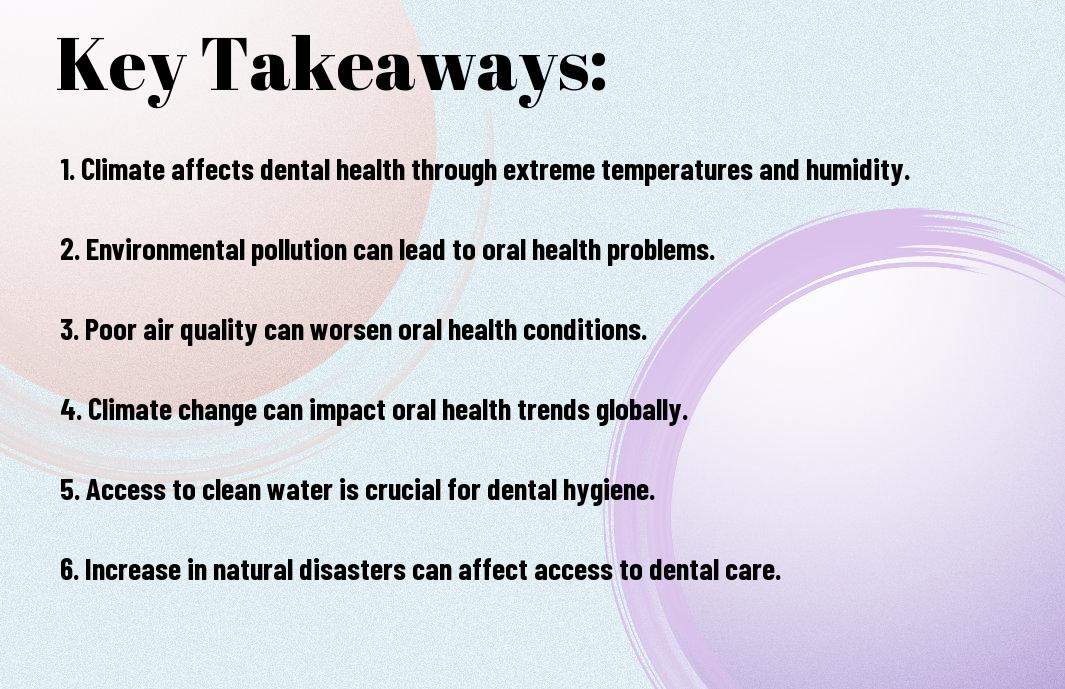You may not realize it, but the changing climate and environmental factors around us can significantly affect our oral health. From extreme temperatures to air pollution, these elements play a crucial role in the health of our teeth and gums. In this blog post, we will examine into the various ways in which climate change and environmental issues can impact your oral health, and provide tips on how to protect your smile amidst these challenges. Stay informed and empowered to safeguard your oral health against the changing world around us.
The Effects of Temperature Changes on Oral Health
While climate and environmental factors have a significant impact on oral health, temperature changes play a crucial role in affecting the oral cavity. From thermal sensitivity in teeth to the implications of extreme temperatures on oral diseases, understanding these effects is imperative for maintaining optimal oral health.
Thermal Sensitivity in Teeth
Temperature changes can lead to thermal sensitivity in teeth, causing discomfort when consuming hot or cold foods and beverages. This sensitivity is often a result of exposed dentin due to enamel erosion, gum recession, or cavities. When the nerves within the teeth are exposed to extreme temperatures, individuals may experience sharp pain or a lingering sensation.
One way to alleviate thermal sensitivity is by using desensitizing toothpaste or mouthwash that can help block the transmission of sensations from the tooth surface to the nerve. Additionally, maintaining good oral hygiene practices and visiting a dentist regularly can help address underlying issues that may be contributing to thermal sensitivity in teeth.
Implications of Extreme Temperatures on Oral Diseases
Tooth decay and gum disease can be exacerbated by extreme temperature changes. Fluctuations between hot and cold temperatures can weaken the enamel, making teeth more susceptible to decay. Furthermore, extreme temperatures can lead to inflammation of the gums, increasing the risk of gum disease and discomfort in the oral cavity.
| Extreme Temperatures | Implications |
| Hot temperatures | Weaken enamel, increase risk of decay |
| Cold temperatures | Trigger thermal sensitivity, contribute to gum inflammation |
Teeth exposed to extreme temperatures are more prone to damage and require extra care to prevent oral diseases. It is imperative to be mindful of the impact of temperature changes on oral health and take proactive measures to protect and maintain a healthy smile.
| Preventive Measures | Benefits |
| Regular dental check-ups | Early detection of issues, customized treatment plans |
| Using a soft-bristled toothbrush | Gentle on gums and enamel, reduces risk of damage |
Air Quality and Oral Health
Some environmental factors have a significant impact on oral health, and one of the crucial elements is air quality. The quality of the air we breathe can directly affect our oral health in various ways, highlighting the importance of understanding and addressing pollution and its potential consequences.
Pollution-Related Oral Health Issues
Any decrease in air quality due to pollution can lead to several oral health issues. Studies have shown a correlation between poor air quality and an increased risk of conditions such as gum disease, oral cancer, and other oral infections. Pollutants in the air can exacerbate existing oral health problems and contribute to the development of new issues, making it important to minimize exposure to harmful pollutants.
Particulate matter and chemicals present in polluted air can enter the body through inhalation and also affect oral health. These substances can irritate the oral tissues, cause inflammation, and weaken the immune response in the oral cavity, making individuals more susceptible to oral infections and diseases. It is crucial to be aware of the potential impact of pollution on oral health and take proactive measures to protect our oral health in polluted environments.
The Role of Particulates and Chemicals in Oral Health
One key aspect of the impact of particulates and chemicals on oral health is their ability to penetrate the oral tissues and disrupt the natural balance of the oral microbiome. These substances can alter the bacterial composition in the mouth, creating an environment that is more conducive to the growth of harmful bacteria and pathogens. As a result, individuals exposed to high levels of particulates and chemicals in the air may experience a higher incidence of oral health issues.
Role Of Particulates and Chemicals- Understanding the role of particulates and chemicals in oral health is important for creating effective strategies to mitigate their impact. By reducing exposure to pollution, practicing good oral hygiene, and seeking regular dental care, individuals can help protect their oral health and minimize the potential risks associated with poor air quality.
Water Quality and Oral Health
After air, water is the most crucial element to sustain life. The quality of water not only affects general health but also plays a significant role in oral health. Different factors in water, such as fluoride content and contaminants, can have a direct impact on dental health outcomes.
Effects of Water Fluoridation on Dental Health
Fluoridation is the process of adjusting the fluoride content of water to optimal levels for the prevention of dental caries. Fluoride helps to strengthen tooth enamel, making it more resistant to acid attacks that can lead to decay. Communities that have implemented water fluoridation programs have seen a significant decrease in the prevalence of cavities among both children and adults.
Fluoridation of water is considered one of the most cost-effective public health interventions to prevent tooth decay. It is endorsed by major health organizations, including the World Health Organization and the American Dental Association, as a safe and effective way to improve oral health on a population level.
The Impact of Contaminated Water on Oral Diseases
Oral diseases can also be influenced by the quality of water sources. Contaminants such as heavy metals, pesticides, and bacteria in water can pose serious risks to oral health. Ingesting contaminated water can lead to systemic health issues that manifest in the mouth, such as gum disease, oral infections, and even oral cancer.
Plus, contaminated water can also have indirect effects on oral health by promoting the growth of harmful bacteria in the mouth. Poor water quality can disrupt the natural balance of oral flora, making individuals more susceptible to dental problems like cavities and bad breath. It is vital to ensure that water sources are clean and free from harmful contaminants to maintain optimal oral health.
Climate Change, Nutrition, and Oral Health
To understand the intricate relationship between climate change, nutrition, and oral health, it is crucial to examine into how these factors intersect and impact one another. Climate change can significantly influence dietary patterns and food availability, which in turn can have effects on oral health. In addition, nutritional deficiencies resulting from changes in climate can directly impact oral health outcomes.
Influence of Climate on Dietary Patterns
Climate change can lead to shifts in agricultural practices and food production, affecting the availability and accessibility of nutritious foods. Variations in climate patterns may disrupt crop yields and quality, leading to changes in dietary patterns. For example, extreme weather events can reduce the production of fruits and vegetables, crucial for maintaining oral health. This shift towards less diverse and nutritious diets can increase the risk of oral health issues such as dental caries and gum disease.
Nutritional Deficiencies and Oral Health Consequences
Health consequences of nutritional deficiencies due to climate change can have a direct impact on oral health. Inadequate intake of crucial nutrients like vitamins A, C, and D can weaken the immune system and compromise oral health. For example, vitamin C deficiency can lead to gum disease and poor wound healing in the oral cavity. Similarly, low levels of vitamin D can contribute to dental caries and periodontal disease, highlighting the critical role of nutrition in maintaining oral health.
It is crucial for healthcare professionals and policymakers to address the implications of climate change on nutrition and oral health. Education on maintaining adequate nutrient intake, especially during times of food scarcity or climate-related disruptions, is paramount for preventing oral health complications. By understanding the interconnectedness of climate, nutrition, and oral health, we can better adapt and mitigate the impact of environmental factors on overall well-being.
Adaptation and Mitigation Strategies
Public Health Initiatives for Oral Health Preservation
Keep in mind that public health initiatives play a crucial role in promoting oral health preservation amidst changing climate and environmental factors. These initiatives focus on raising awareness about the impact of these factors on oral health and educate the public on preventive measures to adopt.
Any successful public health initiative for oral health preservation involves collaboration between governmental organizations, NGOs, dental professionals, and community members. By implementing community-based programs, conducting screenings, and promoting regular dental check-ups, these initiatives aim to prevent and address oral health issues effectively.
Personal Preventive Measures and Oral Care Adjustments
Preventive measures are equally important for individuals to safeguard their oral health in the face of climate and environmental challenges. Daily practices like proper brushing and flossing, maintaining a balanced diet, and avoiding harmful oral habits can contribute significantly to oral health preservation.
Preventive strategies also include making necessary adjustments in oral care routines based on environmental conditions. For instance, using fluoride-enhanced toothpaste in areas with poor water quality or increasing hydration and moisture levels in the mouth in dry climates can help combat potential oral health issues.
Conclusion
Taking this into account, it is evident that climate and environmental factors play a significant role in determining oral health outcomes. From the impact of air pollution on oral diseases to the increase in dental caries due to changes in temperature and precipitation patterns, it is crucial to consider the effects of a changing climate on oral health. Researchers have highlighted the importance of addressing these issues to mitigate the potential consequences on public health. To learn more, refer to (PDF) Climate Change and Oral Health.







